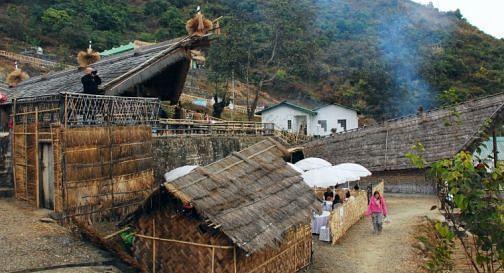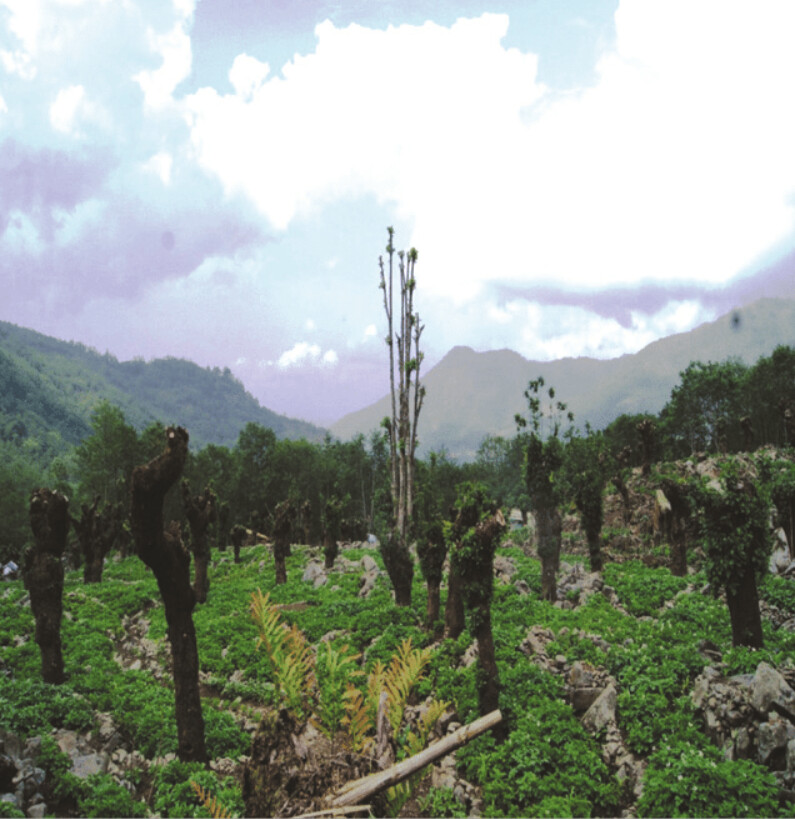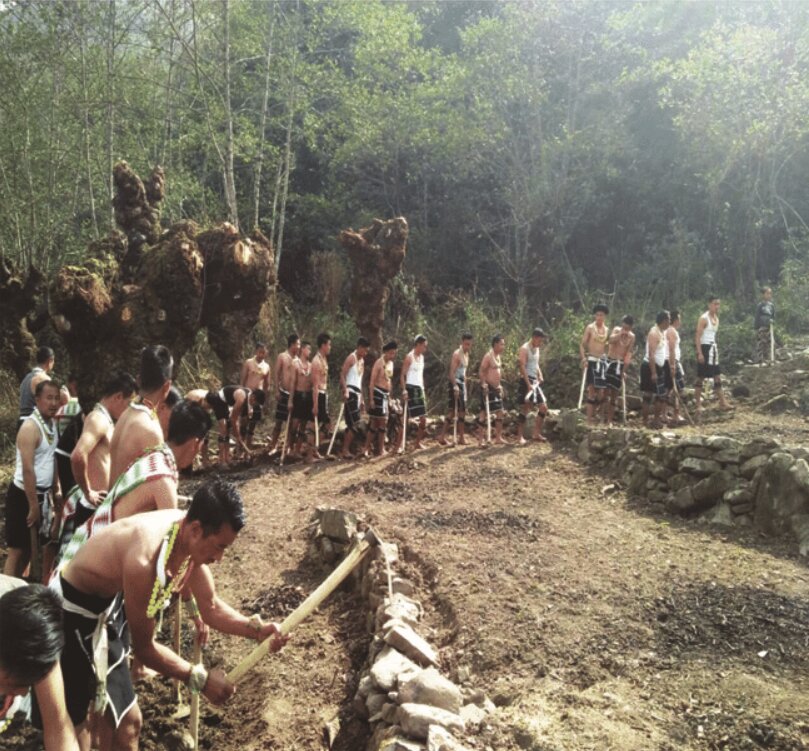On the morning of 18 April 2021, India lost Achyut Madhav Gokhale, one of the country’s finest Indian Administrative Service (IAS) officers, to COVID-19 in Pune. Suffice it to say, his loss was felt personally by the people of Nagaland, whom he served with distinction in different capacities, including as Chief Secretary.
(Image above of the late AM Gokhale and his wife Savita courtesy R. Kevichusa and Twitter/Nitin A. Gokhale)
“Shri Gokhale was an exceptional officer, an optimist, a true leader, and a thinker par excellence who, during his more than three decades of service in the Indian Administrative Service, brought about revolutionary changes. In Nagaland, he developed the concept of the Village Development Board [VDB] which decentralised development to the village level, much before the Panchayati Raj institutions were brought in the rest of the country,” said Nagaland Chief Minister Neiphiu Rio, in an official statement released to the press.
That’s just one of many contributions Gokhale made to the people of Nagaland. As the chief minister concludes, “he will always remain in the hearts of the people of Nagaland”. Passing away at the age of 75, his work remains an example to IAS officers to this day.

A Visionary
Before joining the IAS, Gokhale served in the Indian Navy (1966-1973) as a short service commissioned officer. Serving in its Missile Boat squadron, which saw action in the 1971 War, he was ‘mentioned in dispatches’ for his contributions.
He joined the IAS in 1973 after his stint in the Indian Navy and was allotted the Nagaland cadre with 1968 given as the Year of Allotment. It didn’t take him time to make his mark in the service. As the Deputy Commissioner of Phek district, Gokhale pioneered the concept of ‘Village Development Board’ (VDB)—a statutory body, functioning under the primary village authority known as the Village Council—in Ketsapomi village under the district in 1976.
“The Village Development Board is a mechanism for decentralisation of planning and development at the grassroots level at its best. It includes all the permanent residents of the village as its members functioning under a management committee with a Secretary who is elected democratically for three years. Besides women are to constitute 25% of the total of the management committee. This is a novel scheme of development as the locals understand their needs better and can effectively articulate and implement developmental activities better,” notes anthropology scholar Robert Angkang Shimray in this paper titled ‘Decentralization from Below: A Case Study of Nagaland, India’.
Speaking to The Better India, R Kevichusa, a now-retired IAS officer and former colleague of Gokhale, says, “Back in the day, the Planning Commission would concede to us in various meetings that developmental funds given to state governments for rural areas would barely reach the intended beneficiaries. Out of every rupee sent to the states, only 18 paise would reach the grassroots. The situation in Nagaland wasn’t any different. So, we figured why not transfer a significant chunk of these funds to bodies like a VDB at the village level that they could use to take care of their developmental needs.”
“The institution of the VDBs, which are synonymous with the concept of decentralised grassroot level planning in Nagaland, was first set up in 1976 in Ketsapomi village in Phek District on an experimental basis. Its success launched a mass campaign since [the] 1980s to expand the coverage of this unique institution throughout the State,” notes Shimray in his paper.

From 1976 to 1982, Gokhale led the campaign for the formation of VDBs with total cooperation and support from his colleagues, elders in different villages and members of civil society. As Deputy Commissioner (DC) of Phek and Mokokchung districts, and then as Secretary (Rural Development), where he would supervise the work of other DCs, he went on a drive to establish VDBs that would soon become models of decentralised governance.
“In 1984, there was a trial of strength between the village-level leadership and leaders in the State Government who were bent on watering down the key provisions in the VDB Rules, under the Village Councils Act, which formed the real keel of autonomy. The village level leadership won decisively. I may claim modestly that but for some of my team members standing firm with me, the result of the confrontation would have been the opposite,” says Gokhale in his detailed resume, which one can access online.
Since their inception, these bodies have become a key vehicle in the delivery of government schemes and programmes for rural development.
“The VDB is an institutionalisation of the idea of common property—both creating such a common property and managing it openly, fairly and honestly. This institution has succeeded in surviving the onslaughts of both the state level politics to encroach on people’s autonomy and the ravages of a raging insurgency,” Gokhale adds.
Pankaj Kumar, the former chief secretary of Nagaland, tells The Better India, “The institution of Village Development Board (VDB) is remembered as the lasting legacy of Shri AM Gokhale. Born out of his people-centric and passionate style of functioning, VDBs stand today as a shining example of how the inherent social capital of the community can be harnessed in a structured manner for development. His singular effort in this direction as Deputy Commissioner, Phek mentored the officers who were fortunate to have worked with him. The success of VDBs and Shri Gokhale’s approach in making it happen was a source of inspiration to the generation of bureaucrats, like me, who entered service later.”
It gave rural communities the power to choose and execute development schemes as per their needs and preferences. “VDBs also encouraged communities to save money, a new perspective on monetary management to them. The role of Deputy Commissioner and his team of officers in mentoring VDB leadership and also learning from it has been central to VDBs’ administration. The experiment, which began in Phek district in the late ’70s, was adopted in the entire State by the early ’80s,” adds Kumar.
Underpinning the functioning of VDBs is the concept of ‘communitisation’, although it was only formally introduced in 2002 under the ‘Nagaland Communitisation of Public Institution and Services Act of 2002’. “Communitisation consists of a unique partnership between the government and the community involving transfer of ownership of public resources and assets, control over service delivery empowerment, decentralisation, delegation and building capacities, to improve the delivery of public utility systems,” writes Shimray.
To improve the delivery of public utility systems, bodies like the Village Education Committee, which oversees the management of government-run primary and middle schools in rural areas and the Village Health Committee, which ensures the proper management of primary health centres, emerged. “Another example is communitasion of electricity supply in rural areas. The concept of VDBs, which delegated responsibility to villagers or the actual stakeholders, was carried on to areas like electricity generation too,” says Kevichusa.
Recognising his valuable work on VDBs, Gokhale was awarded the Padma Shri in 1990.
Development Through Collaboration
After a very successful first stint in Nagaland, Gokhale was sent on Central deputation in 1987. Despite the re-emergence of insurgency, VDBs remained intact and functioning. He returned to the state five years later in 1992, and soon embarked on yet another significant initiative called the Nagaland Environment Protection and Economic Development Project (NEPED) as the State’s Agricultural Production Commissioner.
The first problem Gokhale sought to address through NEPED was the rapid soil erosion and deforestation emerging from Jhum cultivation — a form of shifting cultivation.
“Most farming communities in the hilly areas of the Northeast practise slash and burn cultivation, called ‘JHUM’ — an Assamese word. The processes of social life of these tribes are intimately connected to the intricacies of Jhum agriculture, and no amount of efforts under various government-led programmes have succeeded in ‘weaning away the farmers from Jhum’… Government agencies just did not notice the sparks of innovation or fresh thinking by some farmers here and there,” writes Gokhale.
Kevichusa, who closely collaborated in establishing NEPED, reveals how Gokhale’s keen interest in photography played a vital part in addressing the problem of Jhum cultivation.
“In the 1980s, he would go into the villages, take photographs of wet rice field cultivation and get them published in a small collection. Another set of photos he took captured how certain villages would grow the Alder tree alongside their paddy crops. Their root nodules improve soil fertility by fixing atmospheric nitrogen. We got another booklet of photos published on how villagers employed the Alder tree for Jhum cultivation,” he recalls.

“During the early ’80s, Gokhale studied this practice and found that in Naga villages, typically like in Khonoma village [about 20 km from Kohima], farmers grew trees like Alder in the Jhum plot which maintained the ecological balance ensuring green cover as well as food for the village. Gokhale thought that why not replicate this existing model rather than impose an imported one from outside. In 1984-85, Gokhale along with colleague R Kevichusa published a book ‘Use of the Alder Trees’. Before this, no literature was available on Naga’s traditional knowledge about Alder and its benefits in agroforestry,” notes this India Together article.
Under Jhum cultivation, a village community clears a patch of forest, cultivates crops for two consecutive years, abandons this patch and comes back to it after 10 to 12 years. This period allows the forest to regenerate naturally, but due to the rising population, there has been a fall in the yield since the reduction in the duration of the Jhum cycle does not allow sufficient time for the land to recover. This results in soil degradation and deforestation.
“After publishing this booklet, we thought of how to use this Alder tree instead of trying to forcibly wean away villagers from traditional Jhum cultivation. If we could plant Alder trees in Jhum fields along with the main crops like paddy, farmers could cultivate on the land for two consecutive years, and instead of leaving the land fallow for 10 years, they could come back in 5 years. Unlike the more popular ‘slash and burn’ form of Jhum cultivation, here the trees are not felled but pollarded at a certain height. In addition to increasing forest cover, the process of pollarding these alder trees produces a sustainable supply of timber, which ensures further economic benefits for farmers,” says Kevichusa.
“The central activity was to persuade Jhum farmers to plant trees for the timber market, along with the seeds of the food crops, such as paddy or maize or millets in the Jhum fields. In the 5 years of the first phase of NEPED [1995 to 2000], some 5,600 hectares of ‘test plots’ were established in 1,000 villages, and almost 50 indigenous species of trees, totalling 5.6 million trees were planted. Looking at these test plots, other people in villages took up replication in their lands, some on their own and some with the help of the VDB funds. In 2001 it was estimated that the replication covered nearly 36,000 hectares, about six times the acreage under the test plots under the project,” writes Gokhale.

To fund this project, however, Gokhale reached out to foreign contributors because they found it very difficult to convince the Planning Commission in the early years.
“We contacted the Canadians. The GoI was very hesitant to let any foreign entity fund projects in the Northeast, particularly Nagaland and Arunachal Pradesh. Thankfully, the Canadians and the Government of India shared good relations. In a way, NEPED was the first foreign-aided project in Nagaland, a breakthrough of sorts,” recalls Kevichusa.
Funding for NEPED in the early days came from the International Development Research Centre (IDRC) and the Canadian International Development Agency (CIDA) through the India Canada Environment Facility (ICEF). Although the tree planting exercise was discontinued, other developmental projects like rural micro-power projects, access to formal banking and credit and others were started using the same concept and system Gokhale and Kevichusa had set up earlier by forming project teams that would draw officers from various line departments to address different developmental challenges.
“NEPED remains active long after the project. It brought officers involved in the project in a cross-functional way. Officials working in different sectors acquired the skill to work together to conceive and execute multi-sectoral interventions in a holistic manner with support and involvement of the community,” notes Pankaj Kumar.
An Officer Extraordinaire
Highlighting Gokhlae’s work in establishing VDBs and NEPED, however, only touches the surface when it comes to chronicling his contributions to both Nagaland and the rest of India.
“I did not have the opportunity to work under Shri Gokhale’s leadership directly. However, I was fortunate enough to have interacted with him on various issues and I’ve watched him at work in a meeting with VDB Secretaries in Kohima. He loved interacting with people. It was amazing how he remembered names and smaller details about each VDB Secretary. To me, it was a reflection of his deep and intense involvement with them during his days in the field. Shri Gokhale came across truly as an extraordinary gentleman and officer,” says Kumar.
Meanwhile, Kevichusa expresses how Gokhale took the time to understand the people and the communities he helped along the way. “Gokhale understood Nagaland much better than other IAS officers from outside the state. He was very much interested, involved and had a genuine stake in how the State would progress moving forward,” he says.
This is reflected in the statement issued by the Khezhakeno Village Council (KVC) and Khezhakeno Welfare Society Kohima (KWSK), who spoke of how Nagaland lost “a brilliant administrator and a pioneer who had introduced the system of VDB to our people”.
“His special regard to this ancestral heritage village and his love for our people shall be deeply imprinted in our hearts to be cherished,” their statement said.
(Edited by Yoshita Rao)
No comments:
Post a Comment